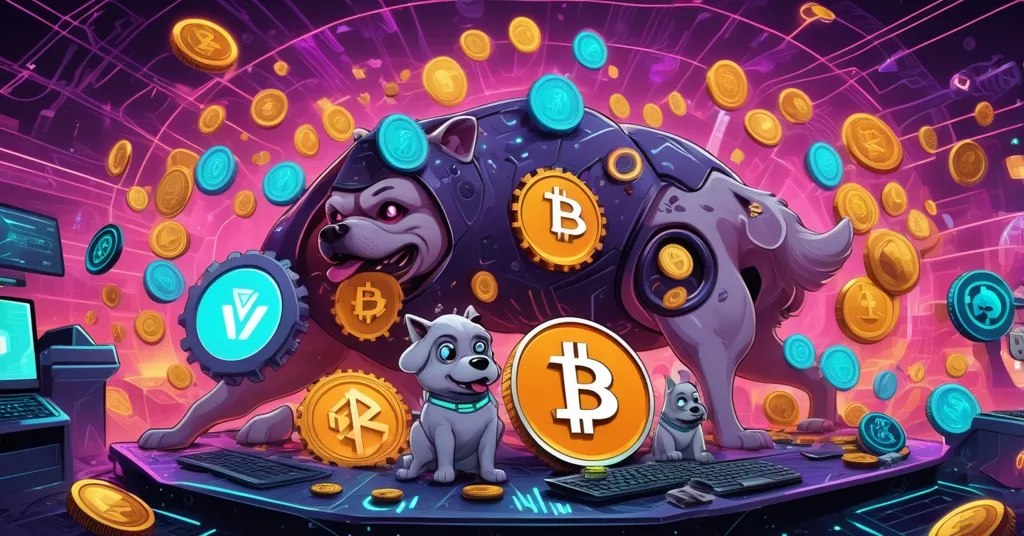Astra Nova’s $RVV Token Launch: Can It Blend $BONK Hype with Solid Infrastructure?

From $BONK to $RVV: Can Astra Nova’s Token Launch Marry Hype with Hard Infrastructure?
The crypto market has seen its fair share of wild rides, but few compare to the raw, chaotic energy of $BONK, a Solana-based meme coin that exploded in late 2022 amidst the rubble of FTX’s collapse. Now, as we look to 2025, Astra Nova’s $RVV token is gearing up for launch on October 18 with a bold promise: to fuse that same community-driven fervor with serious institutional backing and a revenue model that could rewrite the rules of token economics.
- $BONK’s Wild Success: Launched on Solana in December 2022, surged 2,000% in a week on pure community hype.
- $RVV’s Ambitious Blueprint: Backed by NVIDIA, Alibaba Cloud, and a deflationary revenue system, launching in 2025.
- Timing’s Crucial Role: Market conditions and structural differences could define $RVV’s edge—or its downfall.
$BONK: The Meme Coin That Defied Logic
Let’s take a trip back to Christmas 2022. The crypto space was reeling from the catastrophic implosion of FTX, and Solana—tightly linked to the disgraced exchange—was desperate for a spark of hope. Enter $BONK, a meme coin with no fancy tech or detailed roadmap, just a ballsy 50% airdrop to Solana users, NFT holders, and developers. It was less a project and more a rallying cry, a collective middle finger to the despair gripping the market. The community ate it up. Within a single week, $BONK rocketed 2,000%, and by five months, it delivered a jaw-dropping 4,315% return. By December 2023, it had clawed its way to the third-largest meme coin spot, trailing only Dogecoin and Shiba Inu, with listings on major exchanges like Coinbase and Binance adding legitimacy. By November 2024, it peaked at an all-time high of $0.00005916, fueled by integration into Solana’s decentralized apps (dApps) and a fanbase that wouldn’t quit.
But the numbers only tell half the tale. $BONK’s real magic was in its burns—some 12 trillion tokens, worth over $340 million, were torched to reduce supply and hype up scarcity. A standout moment came with the so-called BURNmas event, where 1.69 trillion tokens went up in smoke. That’s meme coin chaos at its finest. Platforms like LetsBonk.fun later piled on, raking in $800,000 in fees over just three days and using the cash to burn even more $BONK, keeping the deflationary fever alive. For comparison, look at Pump.fun, a fee-generating machine that pulled in $15.5 million in a single day by January 2025, amassing over $803 million cumulatively. These stats aren’t just impressive—they’re a glaring neon sign of how speculative frenzy drives revenue in this space, often with little regard for underlying value.
Why did $BONK work when it had no “fundamentals”? Simple: timing and psychology. Launching in a bearish market when Solana needed a win, it tapped into herd behavior and FOMO—fear of missing out—that defines meme coin mania. For newcomers, this is a common pattern in crypto: a token with a funny name or cute dog mascot catches fire not because of tech, but because everyone’s piling in, hoping to catch the wave before it crashes. $BONK proved community sentiment can conjure billions in value from thin air. But let’s not romanticize it—when the party ends, these tokens often leave latecomers holding empty bags.
$RVV: Blending Hype with Heavyweight Support
Fast forward to October 18, 2025, when Astra Nova is set to drop $RVV. This isn’t another meme coin banking solely on Twitter memes and blind optimism. Astra Nova is pitching a hybrid vision—think $BONK’s grassroots passion but backed by the kind of infrastructure that gets traditional finance suits nodding in approval. We’re talking serious players: NVIDIA’s Inception program provides access to cutting-edge tools for building powerful applications, Alibaba Cloud offers a global network across 91 zones to store and run data securely, and Saudi Arabia’s futuristic NEOM project, tied to Vision 2030, brings institutional weight. And the team? It includes founders from Shiba Inu, a name still echoing in meme coin lore. This isn’t just a token launch; it’s a calculated bet on blending community soul with corporate muscle, as detailed in discussions around Astra Nova’s unique token launch strategy.
So, what sets $RVV apart in this crowded crypto token launch landscape of 2025? Its ecosystem is already humming with 250,000 creators and millions of users through TokenPlay AI, a blockchain gaming platform integrating major intellectual properties (IPs) like Shiba Inu and Simon’s Cat. For the uninitiated, IPs are well-known brands or characters—think a beloved cartoon feline—that come with built-in fanbases, making them gold for attracting users to games or apps. TokenPlay AI isn’t just a shiny buzzword; it’s the engine behind $RVV’s revenue model. Platform fees from transactions automatically trigger buybacks and burns of $RVV tokens, creating what’s known as deflationary pressure. In plain terms, this means reducing the total number of tokens over time, which can boost scarcity and potentially drive up value if demand holds steady. Unlike $BONK’s one-off burn stunts, this is a baked-in mechanism meant to scale with usage.
But can TokenPlay AI really turn casual gamers into $RVV believers? That’s the multi-million-dollar gamble. While specifics on its blockchain—whether it’s Solana, Ethereum, or another chain—aren’t fully public yet, the platform will need to tackle real challenges like scalability (handling thousands of users without crashing) and onboarding (making it easy for non-crypto folks to join). If it flops on adoption, those fancy buyback-and-burn promises are just hot air. Still, launching with an existing user base and recognizable IPs gives $RVV a head start most tokens can only dream of.
Timing and Market Context: A Tale of Two Eras
Timing was everything for $BONK, and it’s no less critical for $RVV. Back in 2022, $BONK hit the scene when Solana’s community was starved for positivity post-FTX. It thrived in a bearish market not despite the gloom, but because of it—offering a lifeline of hope. $RVV, on the other hand, steps into a 2025 landscape that’s shaping up differently. Institutional money is returning, with heavyweights like BlackRock dipping deeper into crypto. Regulatory fog is clearing in key regions, and Bitcoin’s post-halving trajectory—typically a bullish signal after supply cuts—could lift the entire market. This isn’t the desperate, anything-goes vibe of 2022; it’s a maturing space where utility is starting to matter more than memes.
Astra Nova seems to get this shift, positioning $RVV as a token with both community appeal and structural depth for decentralized ecosystems. But let’s not chug the Kool-Aid just yet. The crypto market of 2025 will also be crowded with competing token launches, many promising “revolutionary” tech or partnerships. Historical data backs this skepticism—post-halving bull runs often inflate hype, but they also expose weak projects when the tide recedes. $RVV’s success isn’t guaranteed by a favorable market; it’ll need to prove TokenPlay AI can sustain real activity, not just speculative buzz.
Risks and Realities: Can Infrastructure Beat Instinct?
Let’s cut through the optimism with some hard-nosed reality. Meme coins like $BONK showed that hype can defy gravity, but they also crash spectacularly when the music stops. $RVV’s partnerships with NVIDIA and Alibaba Cloud sound impressive, but blockchain history is littered with “game-changing” projects that flamed out despite big-name backers. Remember BitConnect, the 2017 darling that promised guaranteed returns with flashy marketing? It collapsed into a Ponzi scheme, wiping out billions. Or take countless ICOs from the 2018 craze—many boasted corporate ties but delivered nothing but broken promises. $RVV isn’t immune to this curse just because it has a revenue model on paper.
Speaking of revenue, the success of platforms like Pump.fun—with its $803 million in cumulative fees—reveals both opportunity and danger. Those numbers scream potential for fee-driven ecosystems, but they also expose crypto’s speculative underbelly. Most of that cash comes from traders chasing the next 100x moonshot, not from sustainable use cases. If $RVV’s TokenPlay AI becomes just another hype machine without real user engagement, it risks falling into the same trap. And let’s not pretend institutional support is a golden ticket. Ties to entities like NEOM, while adding credibility, can bind projects to external agendas. Bitcoin purists might scoff at this—crypto was born to escape centralized control, not cozy up to governments and corporations. Is $RVV advancing decentralization, or just dressing up speculation in fancier clothes?
Then there’s the question of ethos. As champions of effective accelerationism, we see $RVV as a test case for speeding up crypto’s maturation through tech integration, even if it flirts with centralization risks. But acceleration isn’t always smooth—short-term volatility or overreliance on partners could derail the vision. Compared to past hybrid attempts like SafeMoon, which hyped a deflationary model before collapsing amid lawsuits and rug-pull accusations, $RVV’s approach feels more polished. Yet, the jury’s still out on whether infrastructure can capture the viral magic of a no-frills meme coin—or if that raw, irrational energy is the real fuel of this market.
Key Questions and Takeaways
- What sparked $BONK’s unbelievable rise with zero fundamentals?
Community passion and impeccable timing during Solana’s post-FTX slump turned $BONK into a beacon of hope, showing raw sentiment can trump traditional value metrics. - How does $RVV plan to differentiate from meme coins like $BONK?
With backing from NVIDIA and Alibaba Cloud, plus a deflationary buyback-and-burn system via TokenPlay AI, $RVV aims to blend viral hype with tangible substance. - Why is timing so pivotal for crypto token launches?
Market mood drives adoption—$BONK soared in despair, while $RVV’s 2025 debut aligns with institutional inflows and clearer regulations, potentially amplifying its reach. - Can a revenue model guarantee a token’s staying power?
$RVV’s automated burns tied to platform fees offer a sustainable edge over $BONK’s sporadic efforts, but only if TokenPlay AI generates consistent, real user activity. - Does institutional backing help or hinder crypto projects?
While NVIDIA and NEOM lend $RVV credibility, they also risk diluting the decentralized spirit of crypto, tying it to agendas that may clash with freedom and privacy.
As $RVV’s launch date nears, the crypto world is watching with a mix of intrigue and skepticism. Astra Nova is swinging for the fences, betting that infrastructure and community can coexist in a market still drunk on speculation. Whether it carves a new path for token economics or gets lost in the noise of the next dog-themed fad, one truth stands: timing isn’t just a factor—it’s the battlefield. And in 2025, $RVV will either prove that substance can match imagination or remind us why hype often wins.


